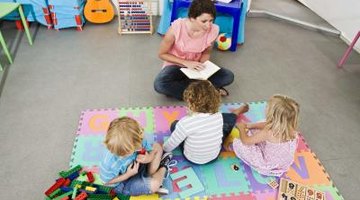Cause and effect relationships are an important lesson in logical thinking. You can use a few fun classroom activities to teach your kindergarten students how the cause and effect events connect to each other, cause events occurring and creating effect events. Cause and effect relationships occur all around your students, but you can introduce children to them with reading lessons, a cooking exercise, flash card games or a drawing project.
Reading Lesson
Select a book to read to your class. Mystery books are ideal for lessons on cause and effect because the investigation process is a series of cause and effect relationships. Remind your students about cause and effect relationships, and then begin reading the story to your kindergarten class. Pause when you run into a clue in the story, and ask your students to explain whether the clue represents a cause or an effect. Then ask them to speculate on what the clue suggests about the other. For instance, if Sally discovers an unlocked door, your students may decide that this is an effect, and that the cause is the villain entering through the door earlier.
Cooking Lesson
Set up a hot plate in your classroom, making sure you warn students to keep their distance from the device. Begin showing your students how to make hot chocolate with the hotplate. Explain that each ingredient is a cause and instruct them to tell you the effects. Hold up an ingredient, showing it to your class, and ask them to tell you the effect of putting that ingredient into your hot chocolate. As an example, you may hold up a cup of sugar, and wait for them to tell you that the effect is making their hot chocolate sweeter.
Flash Card Game
Use flash cards that have a number of random pictures on one side, or instruct your students to draw flash cards with different pictures on each. Shuffle the flash cards in a single deck. Instruct a student to draw two cards, placing them face up in front of her. Explain that she should look at her two cards and form a cause and effect relationship between the two images, in story form. When she is ready, ask her to tell the short story about how one card caused the other. Once she is done, move on to the next student. For instance, she may draw a card with a cat and another with a police officer, and decide that the cat ran away (cause) and its owner called the police (effect) to help look for it.
Drawing Project
Divide your class into groups of two and instruct them each to draw a picture. One student will draw a picture of a cause, and the other a picture of an effect. Give them time to discuss their pictures and then instruct them to begin. Separate each group while they are drawing. This project demonstrates the dependence that cause and effect relationships have on each other, as your students rely on their partner to draw the other event.
Related Articles
References
Writer Bio
Kristyn Hammond has been teaching freshman college composition at the university level since 2010. She has experience teaching developmental writing, freshman composition, and freshman composition and research. She currently resides in Central Texas where she works for a small university in the Texas A&M system of schools.











